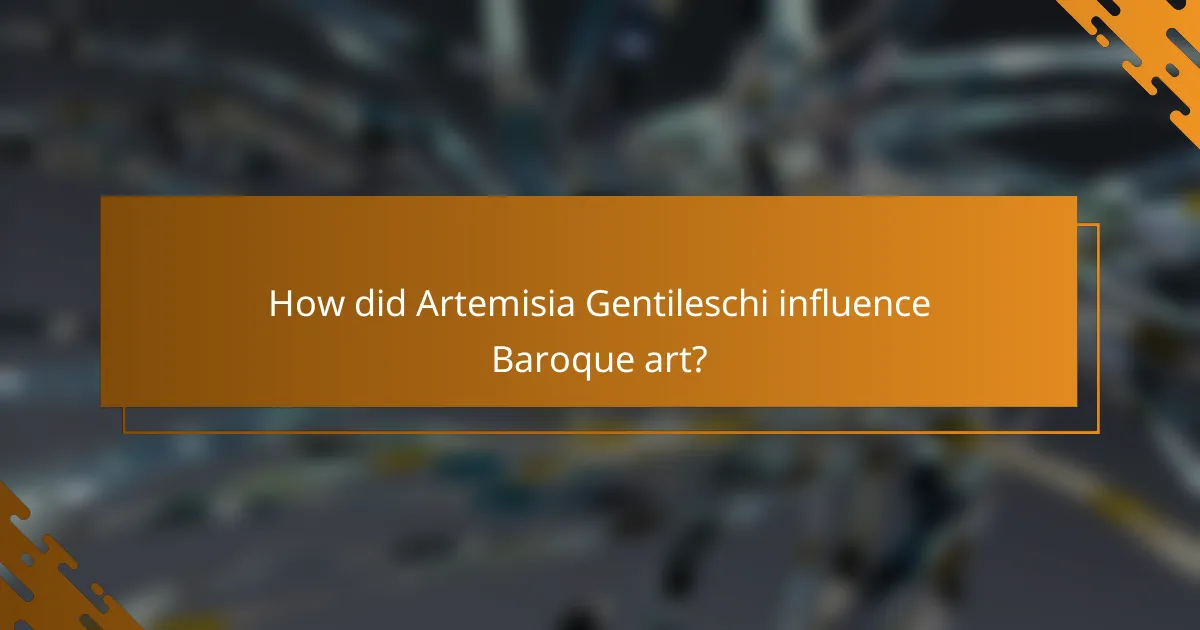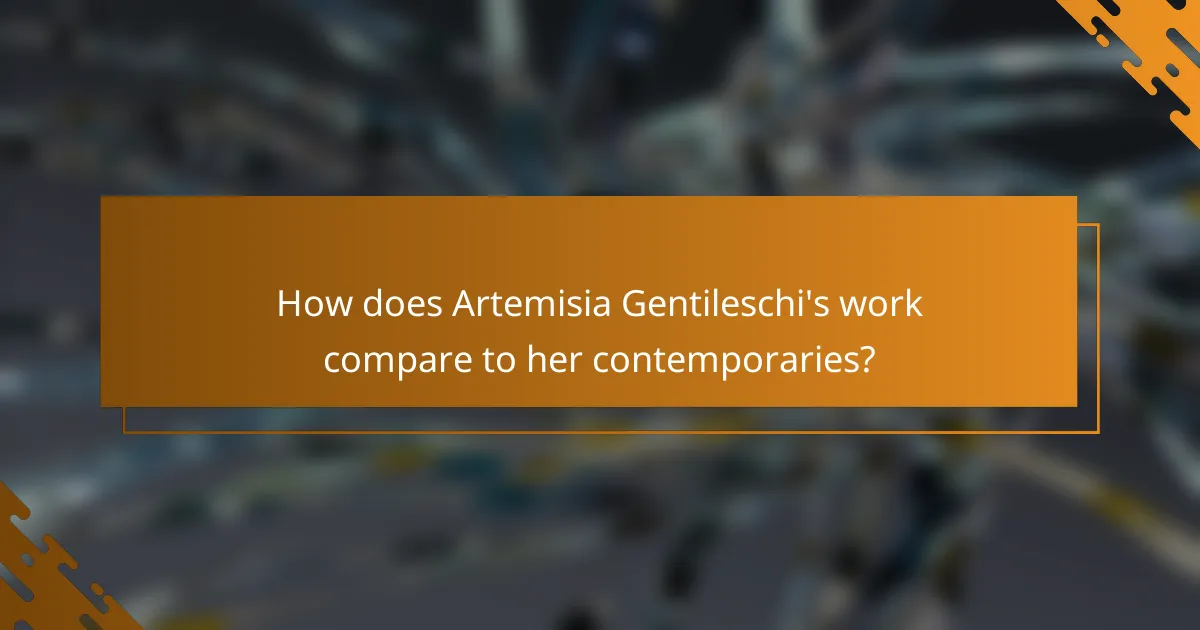Artemisia Gentileschi was a pioneering figure in Baroque art, renowned for her innovative techniques and powerful themes that challenged traditional gender roles. Her work often explores feminism, violence, and religious or mythological narratives, reflecting both her personal experiences and broader societal issues. Through her mastery of oil painting and dynamic compositions, Gentileschi created art that resonates with emotional depth and realism.

How did Artemisia Gentileschi influence Baroque art?
Artemisia Gentileschi significantly influenced Baroque art through her innovative techniques and powerful themes. Her work challenged traditional gender roles and introduced a new perspective on female representation in art.
Innovative use of chiaroscuro
Gentileschi’s mastery of chiaroscuro, the contrast between light and shadow, set her apart in the Baroque movement. She employed this technique to create dramatic effects, enhancing the emotional intensity of her subjects. For instance, in her famous painting “Judith Slaying Holofernes,” the stark contrasts highlight the tension and violence of the scene.
This innovative use of light not only drew viewers into the narrative but also emphasized the psychological depth of her characters. By manipulating light and shadow, Gentileschi was able to convey complex emotions, making her work resonate with audiences on a deeper level.
Depiction of strong female figures
Gentileschi’s art is renowned for its portrayal of strong, assertive female figures, often drawn from biblical and mythological stories. Unlike many of her contemporaries, she depicted women as powerful protagonists rather than passive subjects. This approach is exemplified in her depiction of Judith, who is shown as a fierce and determined warrior.
By focusing on the strength and agency of women, Gentileschi challenged the male-dominated narratives of her time. Her works served as a form of empowerment, inspiring future generations of artists to explore female strength and resilience in their own creations.
Integration of personal narrative
Gentileschi’s integration of personal narrative into her artwork adds a unique layer of meaning to her pieces. Her own experiences, including her struggles with gender-based violence and societal expectations, influenced the themes and characters she portrayed. This personal connection is particularly evident in works like “Self-Portrait as the Allegory of Painting,” where she presents herself as an artist in control of her narrative.
This autobiographical element invites viewers to engage with her work on a more intimate level, as they can sense the emotional weight behind her subjects. By weaving her personal story into her art, Gentileschi not only enriched her own work but also contributed to a broader dialogue about women’s experiences in society and art.

What are the key themes in Artemisia Gentileschi’s work?
Artemisia Gentileschi’s work prominently features themes of feminism, violence, and religious or mythological narratives. These themes reflect her personal experiences and broader societal issues, making her art both deeply personal and universally relevant.
Feminism and female empowerment
Feminism and female empowerment are central to Gentileschi’s artwork, often portraying strong women who defy societal norms. Her paintings frequently depict female figures from history and mythology, showcasing their strength and resilience in the face of adversity.
For example, in her famous work “Judith Slaying Holofernes,” Gentileschi illustrates Judith as a powerful and determined figure, challenging traditional representations of women as passive or submissive. This focus on empowered female characters resonates with contemporary feminist discourse.
Violence and revenge
Violence and revenge are recurring motifs in Gentileschi’s paintings, often reflecting her own life experiences, including her traumatic past. Many of her works depict scenes of vengeance, where women take control of their narratives through acts of violence against their oppressors.
Her portrayal of violent themes is not gratuitous; instead, it serves as a commentary on the injustices faced by women. The intensity of these scenes invites viewers to confront the harsh realities of gender-based violence and the struggle for justice.
Religious and mythological subjects
Religious and mythological subjects are prominent in Gentileschi’s oeuvre, providing a rich context for exploring complex themes. She often reinterprets biblical and mythological stories, placing women at the forefront of these narratives.
In works like “Susanna and the Elders,” Gentileschi not only tells a well-known story but also emphasizes the moral strength of her female characters. By doing so, she challenges traditional depictions and invites viewers to reconsider the roles of women in these historical and religious contexts.

What techniques did Artemisia Gentileschi employ?
Artemisia Gentileschi employed a range of innovative techniques that set her apart in the Baroque art movement. Her mastery of oil painting, dynamic compositions, and ability to convey realistic human emotions were key elements in her work.
Oil painting mastery
Gentileschi was renowned for her exceptional skill in oil painting, which allowed her to create rich textures and vibrant colors. She often used a technique called chiaroscuro, which emphasizes the contrast between light and shadow, enhancing the three-dimensionality of her subjects. This mastery contributed to the dramatic effect seen in many of her pieces.
Her use of layered glazes added depth and luminosity to her paintings, making them visually striking. For example, her famous work “Judith Slaying Holofernes” showcases her ability to manipulate oil paints to create lifelike skin tones and intricate details in fabric.
Dynamic composition
Gentileschi’s compositions are characterized by their dynamic arrangements and strong diagonal lines, which draw the viewer’s eye across the canvas. She often employed asymmetry to create tension and movement, making her scenes feel alive and engaging. This approach was particularly effective in narrative scenes, where the action unfolds dramatically.
In “Susanna and the Elders,” for instance, the positioning of the figures and the use of space create a sense of urgency and conflict, compelling the viewer to engage with the story being told. Her innovative compositions often broke away from traditional norms, showcasing her unique artistic vision.
Realistic human emotion
One of Gentileschi’s most notable techniques was her ability to portray realistic human emotions, which added depth to her characters. She focused on the psychological states of her subjects, capturing expressions of fear, determination, and strength. This emotional authenticity resonates with viewers, making her work relatable and impactful.
In her paintings, such as “Mary Magdalene in Ecstasy,” the nuanced expressions and body language convey complex feelings, inviting the audience to connect with the characters on a personal level. Gentileschi’s emphasis on emotion not only enhances the narrative but also reflects her own experiences as a woman artist in a male-dominated field.

How does Artemisia Gentileschi’s work compare to her contemporaries?
Artemisia Gentileschi’s work stands out among her contemporaries due to her unique blend of dramatic realism and strong female protagonists. While many artists of her time focused on traditional themes, Gentileschi’s paintings often depicted powerful women from mythology and the Bible, reflecting her personal experiences and societal issues.
Comparison with Caravaggio
Artemisia Gentileschi’s work shares significant similarities with Caravaggio, particularly in the use of chiaroscuro, which emphasizes the contrast between light and shadow. Both artists employed dramatic lighting to enhance emotional intensity, yet Gentileschi’s subjects often convey a sense of female empowerment that is less prominent in Caravaggio’s male-dominated narratives.
While Caravaggio’s compositions frequently focus on violence and moral ambiguity, Gentileschi’s portrayals of women, such as Judith and Susanna, highlight their strength and resilience. This thematic shift not only differentiates her from Caravaggio but also aligns her with the emerging discourse on women’s roles in society.
Contrast with other female artists
Compared to her female contemporaries, Artemisia Gentileschi’s work is marked by a boldness that sets her apart. Many women artists of the period faced significant barriers and often produced works that conformed to traditional expectations. In contrast, Gentileschi challenged these norms by creating powerful narratives that center on women’s experiences and struggles.
Additionally, while some female artists focused on still lifes or domestic scenes, Gentileschi’s choice of dramatic historical and biblical subjects allowed her to engage with themes of agency and justice. This distinctive approach not only showcases her technical skill but also underscores her role as a pioneer for women in the art world.

What are the modern interpretations of Gentileschi’s art?
Modern interpretations of Artemisia Gentileschi’s art often emphasize her role as a pioneering female artist who challenged societal norms and expressed themes of female empowerment and resilience. Her works are viewed through various lenses, including feminist perspectives that highlight her unique experiences as a woman in a male-dominated art world.
Feminist art criticism
Feminist art criticism has played a significant role in reshaping the understanding of Gentileschi’s contributions to art. Critics analyze her paintings not only for their technical prowess but also for their commentary on gender and power dynamics. Her depictions of strong female figures, often drawn from biblical and mythological narratives, serve as a critique of patriarchal structures.
Many feminist scholars argue that Gentileschi’s personal experiences, including her struggles with sexual violence and societal limitations, inform her art. This perspective encourages viewers to consider how her life story intersects with her creative expression, making her work resonate with contemporary discussions about women’s rights and representation in the arts.
Influence on contemporary artists
Artemisia Gentileschi’s influence on contemporary artists is evident in the way her themes of female strength and resilience are echoed in modern works. Many artists today draw inspiration from her bold portrayals of women, using similar narratives to explore issues of identity and empowerment. This connection highlights the ongoing relevance of her art in discussions about gender and representation.
Exhibitions and retrospectives dedicated to Gentileschi have sparked renewed interest among contemporary creators, leading to a resurgence of works that reflect her impact. Artists often cite her as a source of inspiration, encouraging a new generation to challenge traditional artistic conventions and explore the complexities of the female experience in their own practices.

How can I purchase artworks inspired by Artemisia Gentileschi?
You can purchase artworks inspired by Artemisia Gentileschi through various channels, including online art galleries and art auctions. Each option offers unique advantages and considerations, allowing you to find pieces that resonate with your taste and budget.
Online art galleries
Online art galleries provide a convenient platform to explore and purchase artworks inspired by Gentileschi. Many galleries curate collections that highlight contemporary artists influenced by her themes and techniques, allowing you to discover new interpretations.
When browsing online, consider factors such as the gallery’s reputation, return policies, and shipping options. Prices can vary widely, often ranging from a few hundred to several thousand dollars, depending on the artist and the artwork’s size and medium.
Art auctions
Art auctions can be an exciting way to acquire unique pieces inspired by Artemisia Gentileschi. Major auction houses frequently feature works that pay homage to her style, and bidding can lead to competitive prices.
Before participating in an auction, research the auction house’s terms, including buyer’s premiums and payment methods. It’s wise to set a budget and stick to it, as auction excitement can lead to overspending. Prices at auctions can fluctuate significantly, so be prepared for a range of outcomes based on demand and rarity.



